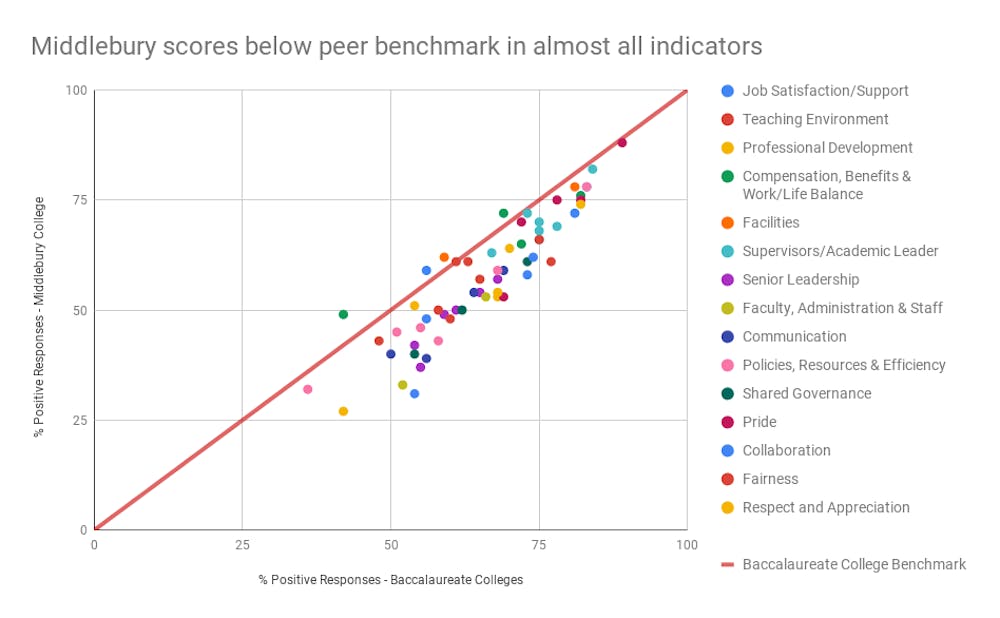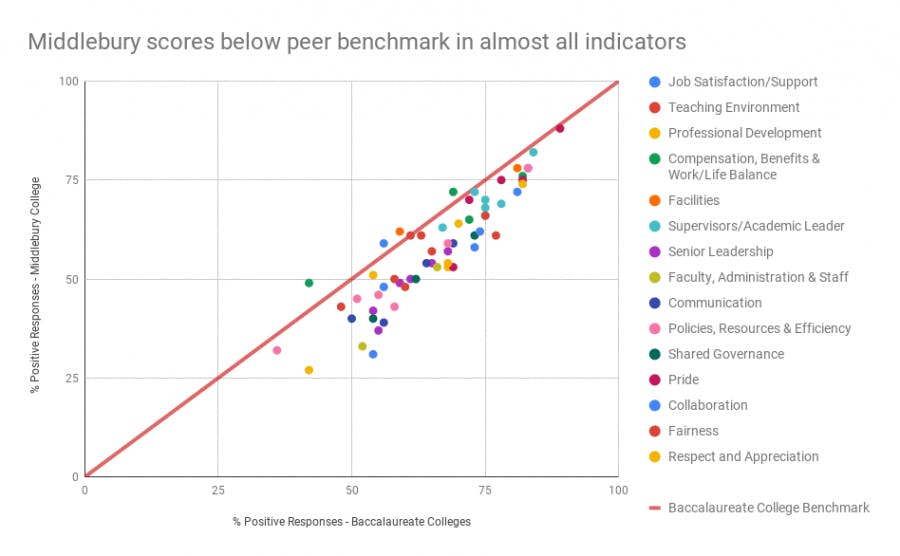Results from a 2017 faculty and staff survey reveal that Middlebury lags well behind its peers in almost all measures of employee satisfaction. Most notably, faculty and staff gave low marks to communication within and between departments as well as confidence in senior leadership.
The consulting firm ModernThink, which has administered similar surveys for colleges and universities across the country, conducted the Middlebury survey in October 2017. 1,046 faculty and staff members across both the Vermont and Monterey campuses took part in the survey — a response rate of 68 percent.
The survey comprised 60 core belief statements included in all ModernThink surveys and seven custom statements provided by the college itself. Faculty and staff responded to each statement expressing their level of agreement on a spectrum from “strongly agree” to “strongly disagree,” creating 67 distinct indicators. For example, one indicator asked respondents to react to the statement: “Our review process accurately measures my job performance.” Grouping responses to each statement into positive, neutral and negative categories, the report — if taken at face value — conveys an overall positive image of job satisfaction at Middlebury.
The Campus obtained the complete survey results, significant portions of which have not previously been released to the student body and general public. In particular, these fuller results include a benchmark that allows for comparison between Middlebury and other baccalaureate colleges that have been surveyed by ModernThink.
Administrators delivered key survey findings at a staff meeting in Dana Auditorium in January 2018, led by then-Interim Provost Jeff Cason, Vice President for Human Resources Karen Miller and ModernThink representative Richard Boyer. While the presentation disclosed Middlebury’s low-performing areas, including perceptions of senior leadership and the effectiveness of communication structures, it juxtaposed Middlebury’s results only with ModernThink’s 2017 Honor Roll of small colleges and not with the national average for baccalaureate colleges.
The honor roll benchmark includes only the highest-performing schools surveyed by ModernThink, numbering nine total in 2017, including institutions such as Mississippi University for Women and New York Chiropractic College. In other words, the presentation exclusively contrasted Middlebury’s performance with those institutions with the very highest levels of staff satisfaction in the country while failing to disclose that Middlebury also consistently performed below the national average for colleges of its kind. Middlebury did not simply fail to reach the highest standard, it also fell short of the average benchmark.
Only five of the 60 core belief indicators met or exceeded Middlebury’s peer group average, with 27 falling into the “Red Flag” and “Acute” classifications defined by ModernThink. “Acute” is a category of performance below “Red Flag,” denoting positive response rates lower than 45%.

A college news release published several weeks after last year’s presentation begins by stating that “a majority of faculty and staff have a positive overall working experience, value the sense of community engendered by Middlebury, enjoy a high degree of ‘job fit,’ and appreciate the flexibility and autonomy their jobs afford.’” The release does not discuss how Middlebury’s results compare to the national averages.
Responding to the survey, the college has developed a four-pronged action plan that addresses the onboarding process for new hires, compensation, the Annual Performance Summary tool and performance management. It includes timelines for each of these areas, hoping to complete all of them by the fall of 2020.
According to Bill Burger, Middlebury’s vice president for communications and chief marketing officer, the survey results have also informed how the administration has conducted the workforce planning process.
“It has certainly underscored the importance of communication on this, and I think we’ve made an effort to communicate more,” he said. “Although my guess is you can never be sufficient in that — there will always be some people who feel they haven’t been communicated to enough.”
Burger said that Middlebury is also looking more closely at compensation rewards and incentives, in response to low scores in those categories.
“A lot of staff didn’t feel there was appropriate recognition for work well-done and that work well-done wasn’t rewarded appropriately in terms of compensation,” Burger said. “So we hope that through this (workforce planning) process we will emerge so that we can be not locked into the annual 2 percent or 2.25 percent increase that goes to virtually everyone, but that we’ll have more flexibility to reward people for a really exceptional performance.”
Still, only 45 percent of respondents expressed confidence when asked if they expected senior leadership to take action based on the results of the survey.
“The administration does not seem to want to listen and they do not seem to care. If you say something, it is held against you,” said one staff member who asked to remain anonymous for fear of retribution. “You are underappreciated no matter what you do.”
By the numbers

A total of 1046 respondents took the survey, with the response rate standing at 68 percent. The majority of respondents work in Vermont and are staff (either exempt or non-exempt).

In the Overall Survey Average, Middlebury performs below the average for Baccalaureate Colleges. 57 percent of responses were positive, 25 percent were neutral, and 14 percent were negative. The percentages do not total to 100 percent because of a “not applicable” option in the survey.

The survey also groups statements into categories. In each sectional average, Middlebury consistently falls below both its peer group and the Honor Roll benchmark.
Breaking down the data into specific statements, the college also fails to meet the national benchmark in each of the individual indicators. Each indicator is plotted with the benchmark score on the x-axis and the Middleburry score on the y-axis. Thus, the 45 degree line represents any point that reaches the benchmark value. Any point below the line represents an indicator not meeting the Baccalaureate average.


There is a stark contrast between perceptions of supervisors/academic leaders and senior leadership. Senior Leadership was amongst one of the three poorest-performing categories — the other two being Communication and Faculty, Administration & Staff Relations.
Faculty and staff expressed a uniform lack of confidence in senior leadership. Only 45 percent of respondents gave positive feedback when asked if they expect senior leadership to take action based on the results of the survey.

Looking forward, morale remains low with workforce planning looming on the horizon. Only 39 percent of respondents expressed confidence in the institution moving forward as a whole.
Graphics by Bochu Ding, using data from ModernThink.
Nick Garber contributed reporting.
For full staff issue coverage, click here.





